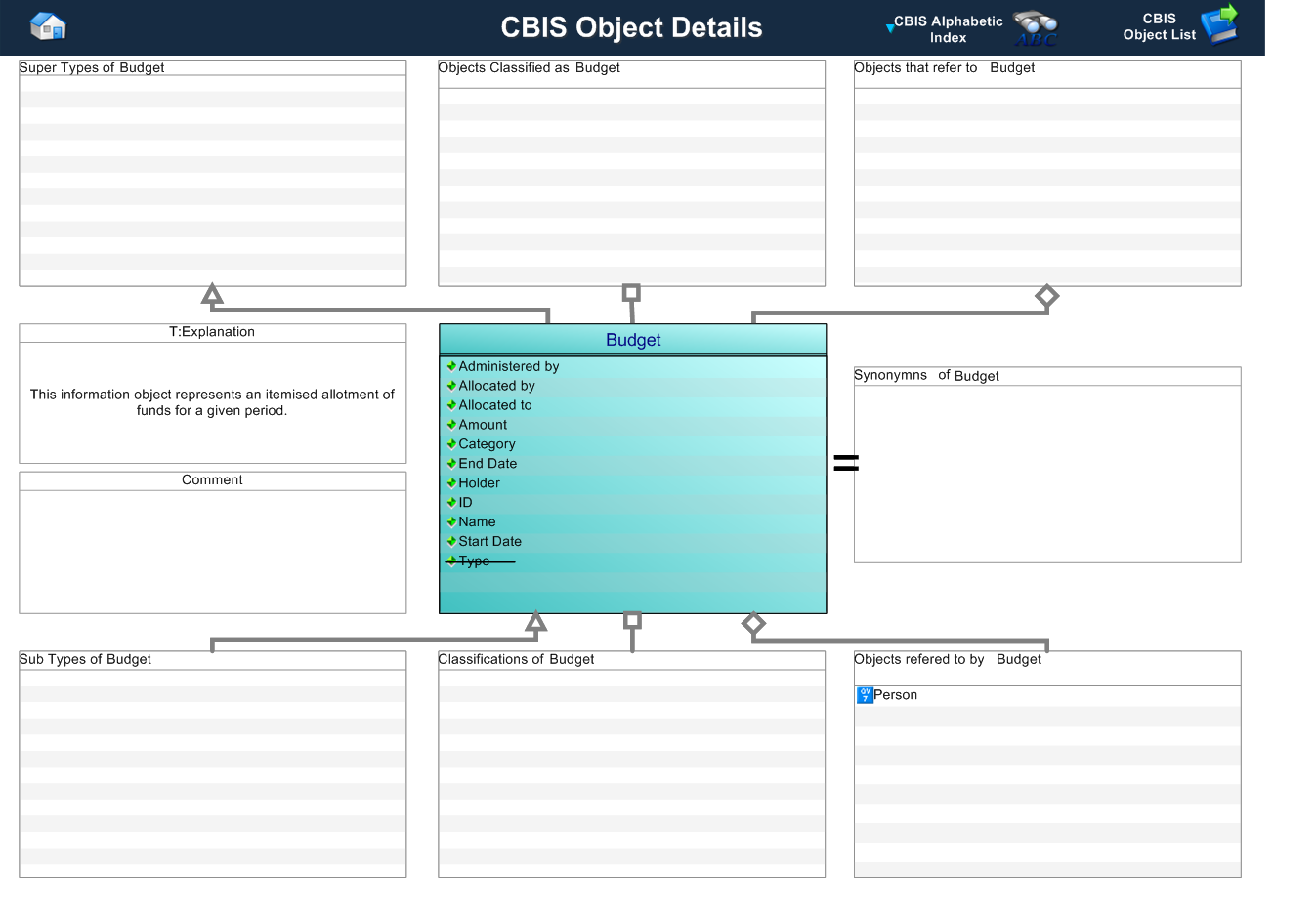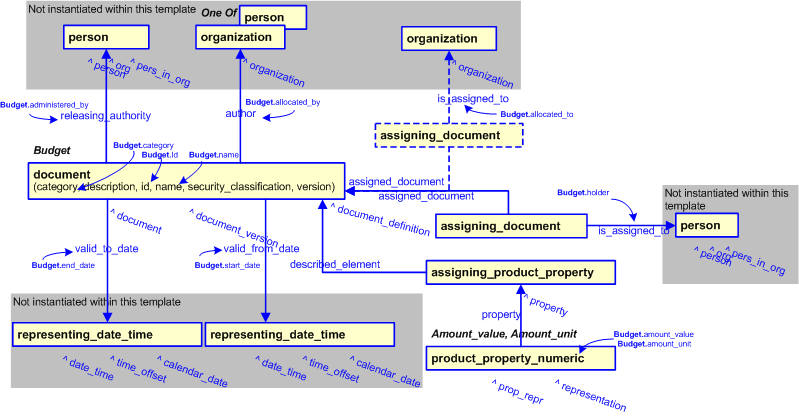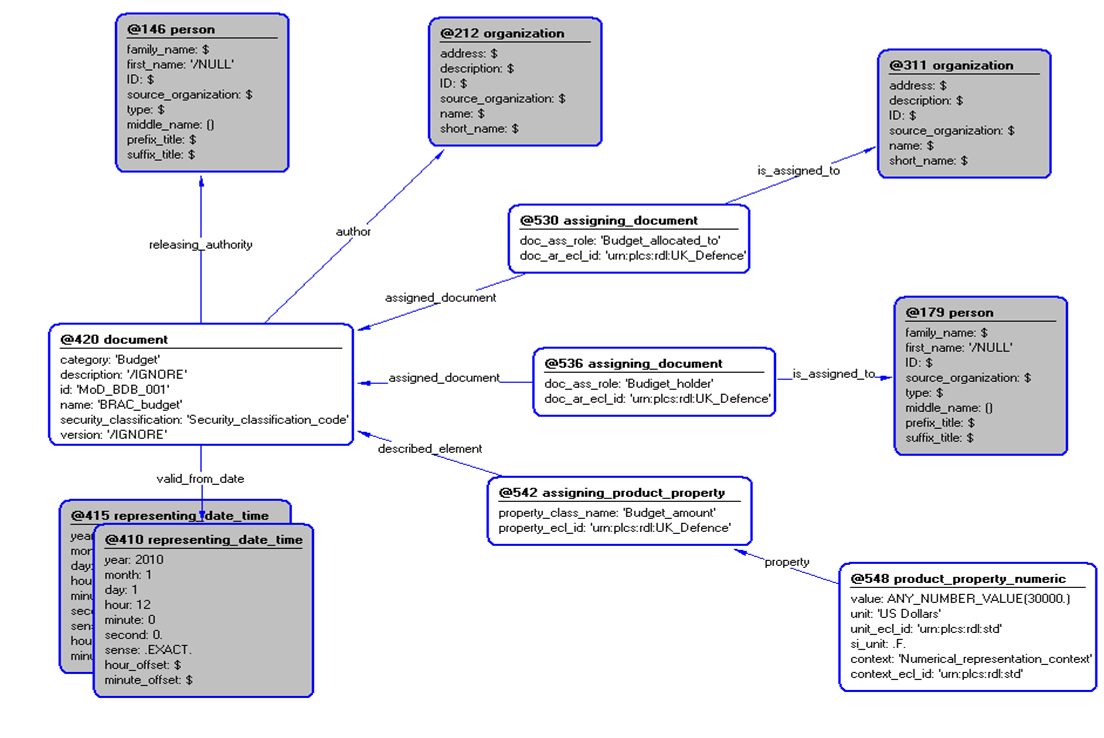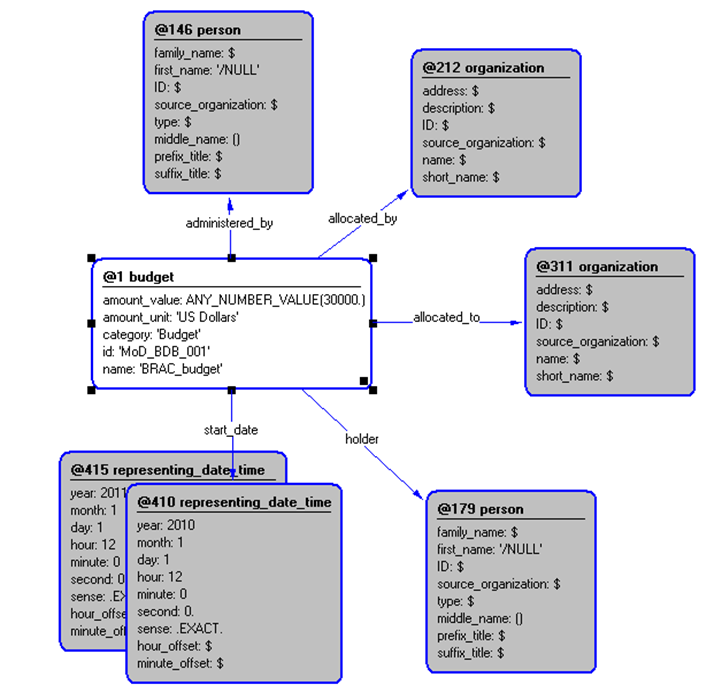Template:— budget (bdgt)
Context:— UK_Defence |
Date: 2010/03/17 16:34:49
Revision: 1.4
|
This section specifies the template budget.
NOTE
The template has been defined in the context of
UK_Defence.
Refer to the business context for details of related templates.
NOTE
An explanation of a template and the associated instantiation path is
provided in the
Template overview
section.
This template describes how to represent the UK_Defence concept of "Budget" in terms of PLCS model elements (templates, entities,
and reference data).
The Budget business object is used by those UK_Defence Data Exchange
Specifications that require information about the allotment and administration of financial funds that are associated
with the specification.
Figure 1 — Graphical Representation for Business ObjectBudget
Budget:
The definition of the Budget object is:
This information object represents an itemised allotment of funds for a given period.
|
Attribute name
|
Attribute description
|
Attribute type
|
Optionality
|
| Administered by |
This is the reference to the Person which administers the budget.
|
Person |
Mandatory |
| Allocated by |
This is the reference to the Person or Organization which allocated the budget |
SELECT relationship to Person or Organization |
Mandatory |
| Allocated to |
This is the reference to the Organization which was allocated the budget. |
Organization |
Optional |
| Amount |
This is the value of the budget. |
intrinsic |
Mandatory |
| Category |
The type of budget |
intrinsic |
Mandatory |
| End Date |
This is the date and time to which the budget is valid. |
intrinsic |
Mandatory |
| Holder |
This is the reference to the Person who holds the budget. |
Person |
Mandatory |
| Id |
This is the Identifier of the budget.
|
Identifier |
Mandatory |
| Name |
This is the name of the budget.
|
intrinsic |
Mandatory |
| Start Date |
This is the date and time from which the budget was valid. |
intrinsic |
Mandatory |
Table 1 — Budget attribute details
The EXPRESS-G diagram in
Figure
2
shows the templates and EXPRESS entities that are required
to represent the template
"budget".
The text highlighted in blue shows the template parameters.
Figure 2 — An EXPRESS-G representation of the Information model for budget
The graphic for the template to be used in other EXPRESS-G diagrams
is shown in Figure
3
below.
Figure 3 — The graphical representation of the budget template
The following input parameters are defined for this template:
The context in which the availability is defined.
The context in which the availability is defined.
The context in which the availability is defined.
The value of the property.
The data type must also be indicated in this parameter, e.g.
"ANY_NUMBER_VALUE(5)".
The class name of the unit in which the value is expressed.
The following classes and their sub-classes can be used:
The category of the property.
The following classes and their sub-classes can be used:
classifications: [Budget]![[warning:]](../../../../../../images/dex/warning.gif) Error RDL4: The URI urn:plcs:rdl:uk_defence is not listed in dexlib/data/refdata/rdl_index.xml
Error RDL4: The URI urn:plcs:rdl:uk_defence is not listed in dexlib/data/refdata/rdl_index.xml
The context in which the availability is defined.
This is the date and time from which the budget was valid.
This is the date and time to which the budget was valid.
The following reference parameters are defined for this template:
Allow the
Document_definition
entity instantiated in this path to be referenced when this template is used.
%^target = $budget.budget%
The instantiation path shown below specifies the entities that are to be
instantiated by the template.
A description of templates and the syntax for the instantiation path is
provided in the
Templates Help/Information section.
-- Instantiate a document to establish the basic budget object Id /
document(
author=@administered_by,
category=@category,
description='/IGNORE',
id=@id,
name=@name,
releasing_authority=@allocated_by,
security_classification='Security_classification_code',
valid_from_date=@start_date,
valid_to_date=@end_date,
version='/IGNORE')/
%^budget = $document.document_definition%
/
assigning_document(
assigned_document=^budget,
doc_ass_role='Budget_allocated_to',
doc_ar_ecl_id='urn:plcs:rdl:UK_Defence',
is_assigned_to=@allocated_to)/
/
assigning_document(
assigned_document=^budget,
doc_ass_role='Budget_holder',
doc_ar_ecl_id='urn:plcs:rdl:UK_Defence',
is_assigned_to=@holder)/
/
assigning_product_property(
property_class_name='Budget_amount',
property_ecl_id='urn:plcs:rdl:UK_Defence',
described_element=^budget)/
-- Assign reference parameter %^property = $assigning_product_property.property%
/
product_property_numeric(
value=@amount_value,
unit=@amount_unit,
unit_ecl_id='urn:plcs:rdl:std',
si_unit='.F.',
context='Numerical_representation_context',
context_ecl_id='urn:plcs:rdl:std',
property=^property)/
The instance diagram in Figure
4
shows an example of the EXPRESS entities and templates that are instantiated by the template:
/budget(administered_by='@146', allocated_by='@212', allocated_to='@311', amount_value='ANY_NUMBER_VALUE(30000.)', amount_unit='US Dollars', category='Budget', holder='@179', id='MoD_BDB_001', name='BRAC_budget', start_date='@410', end_date='@415')/
(an illustration of the consolidated budget template is shown in
Figure
5 below.)
Figure 4 — Entities instantiated by budget template
The instance diagram in
Figure
5
shows the graphic symbol for the template that is to be
used in other instance diagrams. The example template is:
/budget(administered_by='@146', allocated_by='@212', allocated_to='@311', amount_value='ANY_NUMBER_VALUE(30000.)', amount_unit='US Dollars', category='Budget', holder='@179', id='MoD_BDB_001', name='BRAC_budget', start_date='@410', end_date='@415')/
Figure 5 — Instantiation of budget template
Characterizations
No common characterizations of the template
budget
have been identified. However, the ISO 10303-239 EXPRESS model
may enable other assignments to the entities instantiated by the template.




